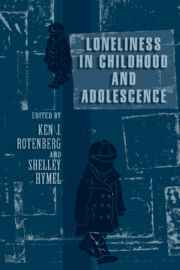Book contents
- Frontmatter
- Contents
- Contributors
- PART I INTRODUCTION
- PART II THEORETICAL AND ASSESSMENT ISSUES
- 2 The Conceptualization and Measurement of Childhood Loneliness
- 3 Understanding the Origins of Childhood Loneliness: Contributions of Attachment Theory
- 4 Developmental Change in the Sources of Loneliness in Childhood and Adolescence: Constructing a Theoretical Model
- 5 Loneliness Through the Eyes of Children
- PART III LONELINESS IN CHILDHOOD
- PART IV LONELINESS IN ADOLESCENCE
- PART V PROSPECTIVE
- References
- Author Index
- Subject Index
- Plate section
3 - Understanding the Origins of Childhood Loneliness: Contributions of Attachment Theory
Published online by Cambridge University Press: 13 October 2009
- Frontmatter
- Contents
- Contributors
- PART I INTRODUCTION
- PART II THEORETICAL AND ASSESSMENT ISSUES
- 2 The Conceptualization and Measurement of Childhood Loneliness
- 3 Understanding the Origins of Childhood Loneliness: Contributions of Attachment Theory
- 4 Developmental Change in the Sources of Loneliness in Childhood and Adolescence: Constructing a Theoretical Model
- 5 Loneliness Through the Eyes of Children
- PART III LONELINESS IN CHILDHOOD
- PART IV LONELINESS IN ADOLESCENCE
- PART V PROSPECTIVE
- References
- Author Index
- Subject Index
- Plate section
Summary
Loneliness is a negative feeling, resulting from a belief that others are unavailable when desired. According to Bowlby's (1969/1982, 1973, 1980) attachment theory, children's early attachments to their parents contribute in important ways to children's beliefs about the availability of others. In this chapter, we consider the contributions of attachment theory and research to the understanding of early childhood loneliness. We begin by proposing ways in which attachment theory can contribute to the debate on the existence of loneliness in childhood. We then present a theoretical model of the connections between attachment and loneliness. We describe the ways in which children's attachment-related cognitive representations – of parents, of the self, of peers – may contribute directly to children's loneliness. Next, we describe more indirect pathways between attachment and loneliness: Attachment is viewed as contributing to loneliness through its influence on children's peer relations, and we review the empirical literature showing connections between attachment and peer relations. Finally, within a transactional framework, we consider the ways in which attachment and peer relations interact with a variety of additional factors to contribute to children's loneliness.
The Existence of Loneliness in Childhood
Any discussion of loneliness in childhood of necessity considers whether children experience loneliness. Earlier theorists suggested that it is not until adolescence that individuals experience loneliness. Sullivan (1953), for instance, described loneliness as a “phenomenon ordinarily encountered in preadolescence and afterward” (p. 261) when the need for intimacy in the context of a close friendship develops. Weiss (1973), similarly, argued that “loneliness proper becomes a possible experience only when in adolescence, parents are relinquished as attachment figures” and the individual can identify “unsatisfactory friendly acquaintances” (p. 90).
Information
- Type
- Chapter
- Information
- Loneliness in Childhood and Adolescence , pp. 34 - 55Publisher: Cambridge University PressPrint publication year: 1999
Accessibility standard: Unknown
- 14
- Cited by
